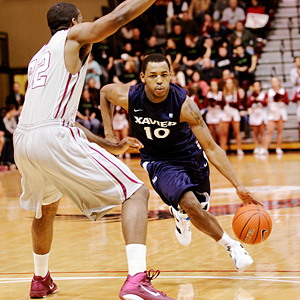| Cheek has loads of swagger. |
Lately though, Lyons seems to have be coming around. Since the beginning of conference play, Lyons has looked like a player who is coming to grips with the value of having hold of the ball. To evaluate how Cheek had improved, I put together a simple formula to rate a possession as empty (EP) or fruitful (FP). A made bucket or an assist equals a fruitful possession; a missed field goal or a turnover makes a possession empty. Finally, since there is value to getting to the free throw line, I weighted in FT as worth .556 of a possession (this number thanks to the wonderful Ken Pomeroy) and put missed ones on the empty side and made ones on the fruitful side. For ease of use, we'll plot the whole thing on a +/- scale (with a positive number meaning the player had more fruitful possessions than empty ones) and call it PPR for Personal Possession Ratio.
If you felt like Lyons was underperforming in non-conference play, the numbers back up what your gut was telling you. During that span of time, he was averaging just over eleven empty possessions per game while coming up productive on just under nine possessions per game. In those 13 games, he was a miserable -30 in PPR. His 52 made buckets, 39 made free throws, and 38 assists came at the cost of 94 missed shots, 18 missed free throws, and 38 turnovers. Cheek was gobbling up possessions (19.5 per game) and not giving X much production for them (12.5 PPG, .356/.345/.684, 1:1 A/TO). Not surprisingly, Xavier staggered out of the gate to an 8-5 record as Tu Holloway (+42 PPR in that time) tried to carry the load alone.
 |
| Defenders are forced to respect Lyon's quickness. |
Part of Cheek's turn around can be attributed to his increased attention to ball security; his assist numbers have seen an insignificant bump, but he has cut back on turnovers by more than half a TO per game. It is Lyons' shot selection that seems to have been the most integral part of his recent increase in production. To exposit what exactly this looks like, I went back through Lyons' shot charts and play-by-play data for the season, breaking down his field goal attempts into layups (this includes all near-rim events such as dunks, layups, and tips), two-point jumpers, and three-point shots.
The difference has not been in his selection of two-point versus three-point baskets; three-point attempts accounted for 37.6% of his shots before the calendar turned and 40.7% of them after. His slightly increased effectiveness from behind the arc also helps each attempt less likely to turn into an empty possession. The most dramatic difference has been in the value of his two-point shots. Before conference play began, 47% of his two-point attempts were jump shots despite the fact that he was hitting 16.3% of them. Since conference began, only 26.7% of Cheek's two-point attempts have been jumpers, and he has hit 25% of them. Layups have jumped from accounting for 53% of his shots inside the arc to 73.3% of them, and he has gone from hitting 54% of them to 68%.
Simply put, Lyons has committed to getting all the way to the rim rather than settling for jump shots, and the results have been spectacular. As he has been more explosive getting to the basket, the respect he garners from opponents has opened up more clean looks from behind the arc. When we were in touch with Mark, he told us that it was his desire to be a "consistent impact player" that has helped him make progress. He also told us he has been getting more and more confident, and with the numbers he has been putting up lately it's no wonder.
 | |
| Lyons serves up the spuds. |
No comments:
Post a Comment